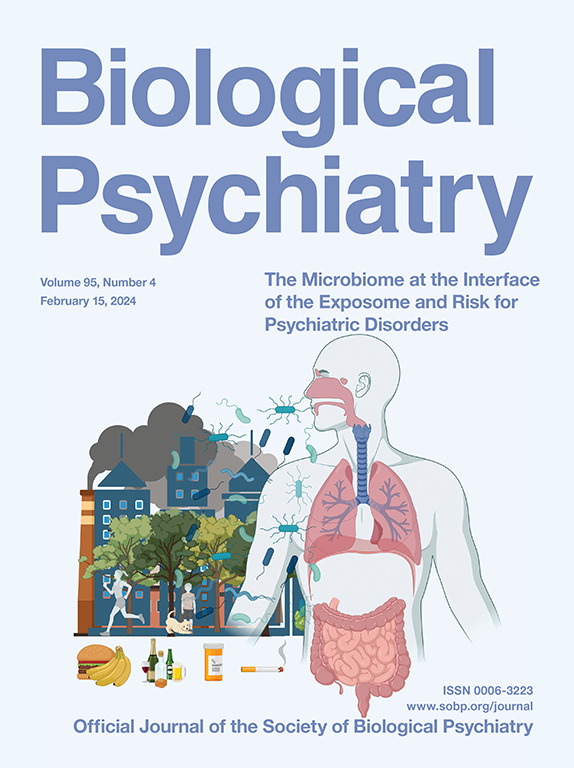Delineating the Heterogeneity of Alzheimer’s Disease and Mild Cognitive Impairment Using Normative Models of Dynamic Brain Functional Networks
IF 9.6
1区 医学
Q1 NEUROSCIENCES
引用次数: 0
Abstract
Background
Alzheimer’s disease (AD), which has been identified as the most common type of dementia, presents considerable heterogeneity in its clinical manifestations. Early intervention at the stage of mild cognitive impairment (MCI) holds potential in AD prevention. However, characterizing the heterogeneity of neurobiological abnormalities and identifying MCI subtypes pose significant challenges.
Methods
We constructed sex-specific normative age models of dynamic brain functional networks and mapped the deviations of the brain characteristics for individuals from multiple datasets, including 295 patients with AD, 441 patients with MCI, and 1160 normal control participants. Then, based on these individual deviation patterns, subtypes for both AD and MCI were identified using the clustering method, and their similarities and differences were comprehensively assessed.
Results
Individuals with AD and MCI were clustered into 2 subtypes, and these subtypes exhibited significant differences in their intrinsic brain functional phenotypes and spatial atrophy patterns, as well as in disease progression and cognitive decline trajectories. The subtypes with positive deviations in AD and MCI shared similar deviation patterns, as did those with negative deviations. There was a potential transformation of MCI with negative deviation patterns into AD, and participants with MCI had a more severe cognitive decline rate.
Conclusions
In this study, we quantified neurophysiological heterogeneity by analyzing deviation patterns from the dynamic functional connectome normative model and identified disease subtypes of AD and MCI using a comprehensive resting-state functional magnetic resonance imaging multicenter dataset. The findings provide new insights for developing early prevention and personalized treatment strategies for AD.
利用大脑动态功能网络的规范模型划分阿尔茨海默病和轻度认知障碍的异质性。
背景:阿尔茨海默病(AD)被认为是最常见的痴呆类型,其临床表现具有相当大的异质性。在轻度认知障碍(MCI)阶段进行早期干预具有预防阿尔茨海默病的潜力。然而,描述神经生物学异常的异质性和识别 MCI 亚型是一项重大挑战:我们构建了动态脑功能网络的性别特异性常模年龄模型,并绘制了来自多个数据集(包括295名AD患者、441名MCI患者和1160名正常对照者(NC))的个体脑特征偏差图。然后,根据这些个体偏差模式,利用聚类方法确定了AD和MCI的亚型,并综合评估了它们的异同:结果:AD和MCI患者被聚类为2个亚型,这些亚型在大脑固有功能表型和空间萎缩模式以及疾病进展和认知能力下降轨迹方面均表现出显著差异。AD和MCI中出现正偏离的亚型与出现负偏离的亚型具有相似的偏离模式。具有负偏离模式的MCI有可能转变为AD,而且这些MCI的认知衰退率更严重:这项研究通过分析动态功能连接组规范模型的偏差模式量化了神经生理学异质性,并利用全面的静息态fMRI多中心数据集识别了AD和MCI的疾病亚型。它为制定早期预防和个性化治疗 AD 的策略提供了新的见解。
本文章由计算机程序翻译,如有差异,请以英文原文为准。
求助全文
约1分钟内获得全文
求助全文
来源期刊

Biological Psychiatry
医学-精神病学
CiteScore
18.80
自引率
2.80%
发文量
1398
审稿时长
33 days
期刊介绍:
Biological Psychiatry is an official journal of the Society of Biological Psychiatry and was established in 1969. It is the first journal in the Biological Psychiatry family, which also includes Biological Psychiatry: Cognitive Neuroscience and Neuroimaging and Biological Psychiatry: Global Open Science. The Society's main goal is to promote excellence in scientific research and education in the fields related to the nature, causes, mechanisms, and treatments of disorders pertaining to thought, emotion, and behavior. To fulfill this mission, Biological Psychiatry publishes peer-reviewed, rapid-publication articles that present new findings from original basic, translational, and clinical mechanistic research, ultimately advancing our understanding of psychiatric disorders and their treatment. The journal also encourages the submission of reviews and commentaries on current research and topics of interest.
 求助内容:
求助内容: 应助结果提醒方式:
应助结果提醒方式:


